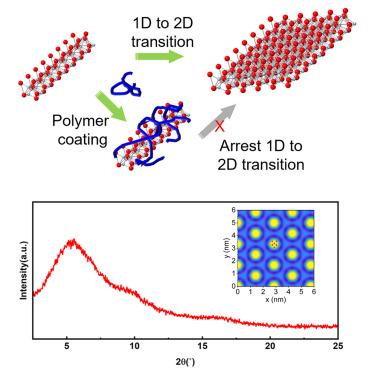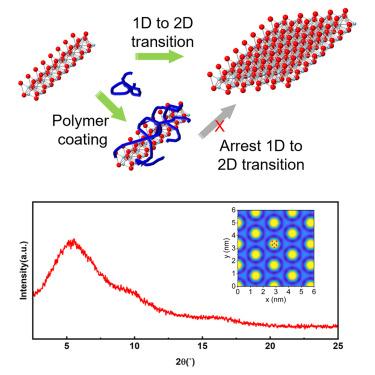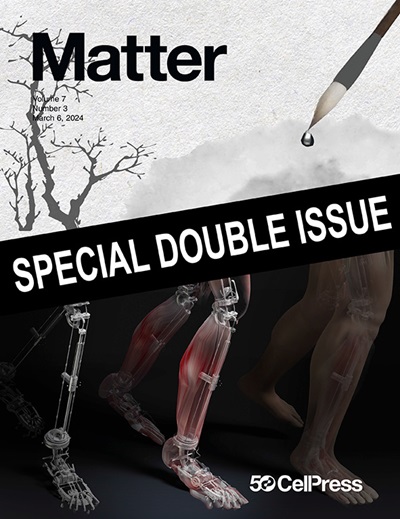Tuning the 1D-to-2D transition in lepidocrocite titanate nanofilaments via polymer wrapping
IF 17.3
1区 材料科学
Q1 MATERIALS SCIENCE, MULTIDISCIPLINARY
引用次数: 0
Abstract
Recently, a solution-based method was developed to synthesize sub-nm thin one-dimensional (1D) lepidocrocite (1DL) titanium-oxide-based nanofilaments as a colloidal suspension. When converted into the solid state, these 1DL nanofilaments self-assemble into 2D layered structures. Herein, we show how a polymer—branched polyethyleneimine (bPEI)—can be used to wrap individual 1DL surfaces and arrest this 1D-to-2D structural transition. X-ray diffraction (XRD) confirmed that the polymer molecules coated onto individual 1DL surfaces. More interestingly, the bPEI-coated 1DLs form a columnar hexagonal liquid crystalline structure in the solid state, and the inter-1DL distances can be readily tuned from 1.66 to 3.00 nm by controlling the polymer-to-1DL volume ratio. Combining the XRD results and density functional theory (DFT) calculations, we conclude that the 1D nanofilaments, on average, are comprised of 2 × 2 edge-shared TiO6 octahedra roughly 0.6 nm in diameter. The tunable liquid crystalline phase could open new opportunities to realize 1DL in multiple applications.


通过聚合物包裹调节鳞片钛酸酯纳米丝的一维到二维转变
最近,研究人员开发了一种基于溶液的方法,以胶体悬浮液的形式合成亚纳米级细的一维(1D)鳞片状氧化钛(1DL)纳米纤丝。当转化为固态时,这些 1DL 纳米纤丝可自组装成二维分层结构。在此,我们展示了如何利用聚合物--支化聚乙烯亚胺(bPEI)来包裹单个 1DL 表面,并阻止这种 1D 到 2D 的结构转变。X 射线衍射 (XRD) 证实聚合物分子包覆在单个 1DL 表面上。更有趣的是,涂覆了 bPEI 的 1DL 在固态下形成了柱状六方液晶结构,通过控制聚合物与 1DL 的体积比,1DL 之间的距离可从 1.66 纳米调整到 3.00 纳米。结合 XRD 结果和密度泛函理论(DFT)计算,我们得出结论:1D 纳米纤丝平均由直径约 0.6 纳米的 2 × 2 边缘共享 TiO6 八面体组成。可调液晶相为实现 1DL 的多种应用开辟了新的机遇。
本文章由计算机程序翻译,如有差异,请以英文原文为准。
求助全文
约1分钟内获得全文
求助全文
来源期刊

Matter
MATERIALS SCIENCE, MULTIDISCIPLINARY-
CiteScore
26.30
自引率
2.60%
发文量
367
期刊介绍:
Matter, a monthly journal affiliated with Cell, spans the broad field of materials science from nano to macro levels,covering fundamentals to applications. Embracing groundbreaking technologies,it includes full-length research articles,reviews, perspectives,previews, opinions, personnel stories, and general editorial content.
Matter aims to be the primary resource for researchers in academia and industry, inspiring the next generation of materials scientists.
 求助内容:
求助内容: 应助结果提醒方式:
应助结果提醒方式:


